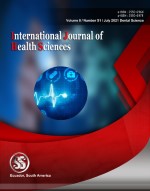Arch form
A review
Keywords:
arch form, bonwill, Hawley, catenary, braderAbstract
Arch form is highly individualized .The universal ideal arch form is the most persistent but exclusive task for most of the orthodontic researchers have. The basic principle of arch form in orthodontic treatment is that within reason, the patient original arch form should be preserved. Dental arch width and form are important Factors for determining the success and stability of orthodontics treatment. Because of the complex problems, And relatively low knowledge of dental arches, as of today, there is no universally accepted ideal arch form. This article gives the review about different concept of arch form, importance arch form from conventional era to modern practice.
Downloads
References
Alexander Sved. 1952. The application of Engineering Methods to Orthodontics. AJO-DO, 38(6):399-421
Allen C. Brader. 1972. Dental arch form related with intraoral forces: PR=C. AJODO, 71(6)541-61
Andreiko C. 1994. The elan and orthos systems. JCO, 28:459.
Arch form in orthodontics: A Review, Amit Tiwari et al, journal of applied dental and medical science, vol 4,march 2018
Andres De La Cruz R, Paul Sampson, et al. 1995. Long – term changes in arch form after orthodontic treatment and retention. A J Orthod Dentofac Orthop., 107:518-30
Angel Edward H. 1907. Treatment of malocclusion of teeth. Edition 7, S.S. White Co., Philadelphia.
Angle EH. 1899. Classification of malocclusion. Dental Cosmos, 41:264-84.
Anwar N. and Fida M. 2010. Variability of arch forms in various vertical facial patterns. J Coll Physicians Surg
Axel F. Lundström 1925. Malocclusion of the teeth regarded as a problem in connection with the apical base. Ajodo, 11(11): 1022-42.
Baluta J. and Lavelle C. 1987. An analysis of dental arch form. European Journal of Orthodontics, (9):165-171
Deckock W.H. 1972. Dental arch depth and width studies longitudinally from 12 years of age to adulthood. Am J Orthod Dentofacial Orthop., 62(1)56-66
Efisio Defraia, et al. 2006. Dental arch dimensions in the mixed dentitions: a study of Italian children born in the 1950s and the 1990s. Angle Orthod., 76:446-51
Felton J. Mark, et al. 1987. A computerized analysis of the shape and stability of mandibular arch form. Am J Orthod Dentofacial Orthop., 92:478-83
George C. Chuck. 1934. Ideal arch form. Angle Orthod., 312- 327
Hawley C. A. 1905. Determination of the normal arch, and its application to orthodontia. The Dental Cosmos, 47(5):541- 552
Interlandi S. 1998. New method for establishing arch form. JCO, 12:843-845
James H Scott. 1957. The shape of the dental arches. J Dent Res., 36:996-1003
Jan Henrikson, et al. 2001. Long term stability of dental arch form in normal occlusion from 13 to 31 years of age. European Journal of Orthodontics, 23:51-61
Knott VB. 1972. Longitudinal study of dental arch width at four stages of dentition. Angle Orthod., 42:387-95
Luca Lombardo, et al. 2010. A new concept of anatomy in lingual arch form. Am J Orthod Dentofacial Orthop., 138: 260.e1-260.e13
Mclaughlin, et al. 2001. Systemized Orthodontic Treatment Mechanics. Elsevier Health Sciences.
Musich DR. and Ackerman JL. 1973. The cantenometer: A reliable device for estimating dental arch perimeter. Am J Orthod., 63:366-75.
Richard A. Riedel. 1960. A review of retention problem. Angle Orthod., 30:179-94
Ricketts RM. 1979. Bioprogressive therapy. Book 1. U.S.A: Rocky Mountain Orthodontics.
Riedel R.A. 1969. Current orthodontic concepts and techniques, Graber T.M., WB Saunders Co.
Robert H.W. Strang. 1946. Factors of influence in producing a stable result in the treatment of malocclusion. Am J Orthod Oral Surg., Jun; 32:313-323
Roth RH, Swain TG. Orthodontics: Current Principle and technique. Louis: CV Mosby Company; 1985.
Rudolph L. Hanau. 1917. The Hawley arch form considered from an engineering stand point- a scientific substitute. Int J Orthod., 635-665
Brader AC. Dental arch form related to intra-oral force: PR = C, Am J Orthod 1972; 61: 541-561.
Published
How to Cite
Issue
Section
Copyright (c) 2021 International journal of health sciences

This work is licensed under a Creative Commons Attribution-NonCommercial-NoDerivatives 4.0 International License.
Articles published in the International Journal of Health Sciences (IJHS) are available under Creative Commons Attribution Non-Commercial No Derivatives Licence (CC BY-NC-ND 4.0). Authors retain copyright in their work and grant IJHS right of first publication under CC BY-NC-ND 4.0. Users have the right to read, download, copy, distribute, print, search, or link to the full texts of articles in this journal, and to use them for any other lawful purpose.
Articles published in IJHS can be copied, communicated and shared in their published form for non-commercial purposes provided full attribution is given to the author and the journal. Authors are able to enter into separate, additional contractual arrangements for the non-exclusive distribution of the journal's published version of the work (e.g., post it to an institutional repository or publish it in a book), with an acknowledgment of its initial publication in this journal.
This copyright notice applies to articles published in IJHS volumes 4 onwards. Please read about the copyright notices for previous volumes under Journal History.
















